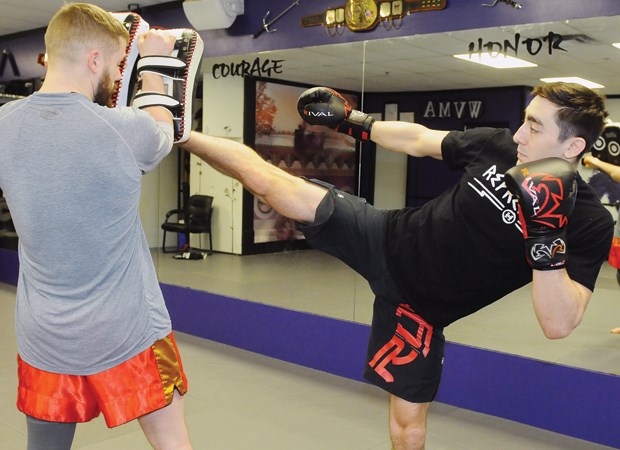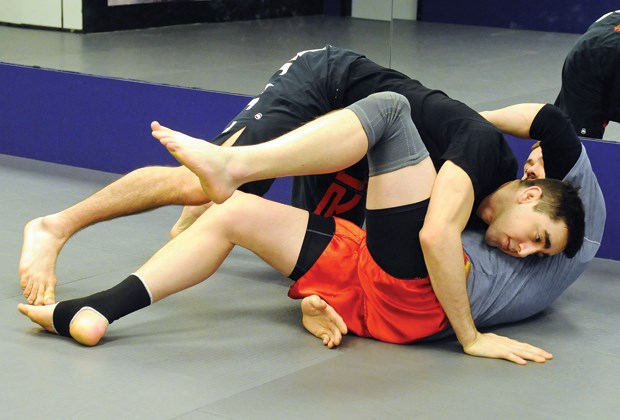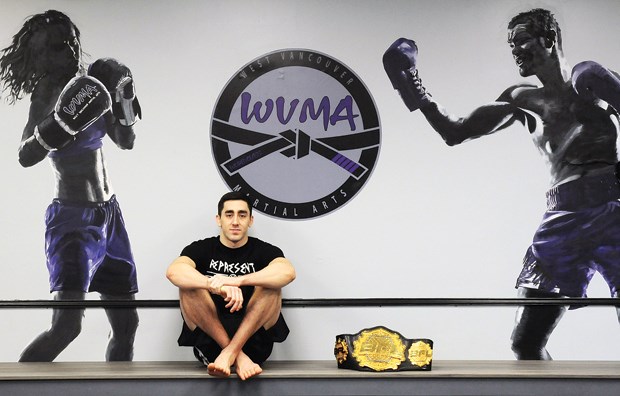It lasted just one minute and 35 seconds.
And if you ask Curtis Harriott he’ll say it wasn’t really a mistake, but the result begs to differ: TKO by injury.
Harriott recorded his ninth win and took the welterweight title belt in the provincial MMA Battlefield Fight League at the end of January when his opponent Ash Mashreghi injured his arm early in the first round.
“I wrapped my arms around his waist and picked him up and when I went to throw him down he landed weird,” recalls Harriott, noting Mashreghi didn’t really make a mistake. “I slammed him and he landed how he landed. He’s a really tough guy so I was expecting to have (the fight) last a lot longer and I’m sure he did as well.”
In October of last year, Harriott experienced almost the exact same result, also early in the fight, when his opponent appeared to post after he was thrown to the ground and his elbow popped out of place.
“It’s unfortunate and I don’t like to see people get hurt, but at the same time in the context of what was going on if that had happened to me I wouldn’t blame them,” says Harriott. “I don’t feel guilty that I did something wrong (but) as a person I feel bad for them.”
At six feet tall and just under 170 pounds, Harriott appears lean and unintimidating in person but his MMA record suggests he’s dangerous in the cage: nine wins in 10 fights, two TKOs by injury and seven wins by submission. One loss by decision.

Less than two weeks after his last fight, Harriott was back at West Vancouver Martial Arts leading a class of youth black belts through some drills.
It’s just one of 20 classes he teaches throughout the week at the local dojo and its Coquitlam counterpart to students that range in age from three to 70.
His polite, almost quiet tone of teaching seems incongruous to the type of aggressive nature expected from an MMA fighter, but Harriott explains that he doesn’t harbour any violent feelings towards his opponents when he enters the ring.
“I don’t have any anger or negative thoughts towards the person. They signed up for it, I signed up for it, and we’re here. This is what we’re doing, and ‘See you on the other side.’”
At 25, Harriott knows the window to pursue a career in mixed martial arts won’t be open long, and so he has committed most of his time to it. If he’s not training, he’s teaching.
“I recognize I have a limited time to do this,” says Harriott. “Once this is no longer an option I can move on and do regular things but it doesn’t work the other way around.”
Training is six days a week, two or three sessions a day, and includes strength and conditioning, jiu jitsu, kickboxing and mixed martial arts with a team of trainers, including former professional fighter Blake Lirette, who co-owns WVMA and serves as his main MMA coach.
“Curtis has a very reserved and humble attitude in general. He has always been uninterested in showing off to others and instead more interested in quietly impressing himself,” says Lirette, who convinced Harriott to pursue competitive MMA.
“When I met Curtis about six years ago he was very passionate about martial arts and put a high value on learning new techniques,” notes Lirette. “He had a very disciplined approach to his learning and training.”
Harriott, who grew up in North Vancouver, took tae kwon do from the age of six to 12. Once in high school, though, he found a new passion: wrestling. He competed for Argyle secondary from Grade 9 to 12, but there weren’t too many wrestling options after high school. That’s when he got back into martial arts.

“I was pretty good at wrestling and I had a desire to continue on with stuff like that even if it was just learning,” he says, but he wasn’t planning on fighting. “I just liked the physical side of it, it’s just something I’ve always kind of been drawn to. I couldn’t wrestle anymore so I just needed a new kind of thing to do.”
When Lirette suggested he pursue professional MMA, Harriott wasn’t so sure.
“It didn’t really match my personality, I’m not really an aggressive person. Especially at the beginning I wasn’t really sure,” he says. “But I’m a competitive guy so I figured I’d at least give it a shot.”
Four years and one major shoulder injury (that required surgery) later, Harriott has won all the BFL amateur titles he can and has defended them. He went pro in July and now gets paid to fight, although he estimates he probably invests more in training than he gets back in winnings. Harriott’s goals have changed, and he now says he would like to be in a position to get a UFC fight by the end of this year. Lirette thinks it’s possible.
“Since we started this MMA journey we were set on him being one of the best in the world and nothing less. If UFC has the top fighters in the world then that’s where we will end up, no doubt. That’s where we are going,” he says.
Harriott agrees with something his coach has insisted since the beginning: that technique will only get him so far and his attitude may be his greastest asset.
“You can have all the skills but if you’re not confident in them then you don’t use them properly and it limits you,” he says. “I am confident but I’m also humble enough to realize that there’s a neverending list of things to improve on and that’s what drives me and what motivates me.”
Harriott admits it has been a lot of hard work and sacrifice with more to come, but so far the effort has been worth it.
“It feels good to succeed in something that you’ve put a lot of time into.”



